Publications by Andrea Young
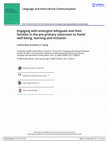
Language and Intercultural Communication, Volume 17, Issue 4, pp. 455-473, 2017
ABSTRACT
This article presents data from a longitudinal study undertaken in a pre-primary classro... more ABSTRACT
This article presents data from a longitudinal study undertaken in a pre-primary classroom of 3–4-year-old emergent bi/plurilingual children during their first year of formal schooling in France. It focuses on how the teacher’s intercultural competence facilitated the emergent bilingual children’s transition from home to school and fostered positive relationships with these parents and included them in the classroom. The data also suggest that the establishment of trusting relationships and safe spaces for these children and their families favoured the emergence of co- educational practices, namely in the area of literacy and fostered their well-being, learning and inclusion.
RESUMÉ
Cet article présente les données issues d’une étude longitudinale dans une classe de petite section maternelle d’enfants bilingues émergents âgés de 3 à 4 ans en France. Il s’intéresse à la façon dont les compétences interculturelles ont facilitéla transition des élèves bilingues émergents de la maison à l’école et ont favorisé les relations positives avec les parents en les incluant dans la salle de classe. Les données suggèrent que l’etablissement des relations de confiance et d’espaces sécurisants contribue a l’émergence de pratiques co-éducatives, notamment dans le domaine de la littératie favorisant ainsi leur inclusion, leur apprentissage et leur bien-etre.
New Perspectives on Translanguaging and Education, 2017
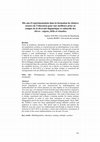
DIVERSITÉ LINGUISTIQUE ET CULTURELLE À L'ÉCOLE: Accueil des élèves et formation des acteurs, Carnets d'Atelier de Sociolinguistique n°11, 2016
Selon de nombreux chercheurs et professionnels de l'éducation en Europe, nos populations scolaire... more Selon de nombreux chercheurs et professionnels de l'éducation en Europe, nos populations scolaires se caractérisent par un plurilinguisme et une multi-culturalité pour lesquels les acteurs de l'éducation ne sont que peu ou pas du tout préparé. Il y a dix ans, une équipe binationale a tenté d'apporter une réponse à cette problématique à travers le projet européen TESSLA. L'objectif de ce projet était de concevoir, d'expérimenter et d'évaluer un module de formation destiné aux professeurs stagiaires du premier degré afin de les sensibiliser aux questions liées au bilinguisme et aux besoins de leurs élèves bilingues émergeants. Depuis 2005, nous avons proposé des variantes de ce dispositif dans des contextes différents, avec des publics variés et selon des modalités diverses. Cet article vise à décrire et à analyser les données recueillies en 2013-2014 et à dresser un bilan critique et constructif des enseignements tirés des différentes modalités de mise en oeuvre.
Abstract According to many researchers and education professionals in Europe, our school populations are now characterized by multilingualism and multiculturalism for which educators are only slightly or not at all prepared. Ten years ago, a bi-national French-Scottish team endeavoured to respond to this question through the European project TESSLA (Teacher Education for the Support of Second Language Acquisition). The remit of this project was to design, experiment and evaluate a training module for trainee primary school teachers in order to raise their awareness of issues related to bilingualism and to the needs of their emergent bilingual pupils. Since 2005, the TESSLA course has been implemented among different contexts and audiences in various ways. This article aims to describe and analyze the different ways the course was implemented and through an analysis of data collected in 2013-2014 to develop a critical and constructive assessment of the results of the course implementation over the past 10 years.
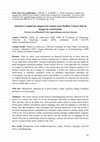
La nouvelle revue de l'adaptation et de la scolarisation (NRAS), N°73, 1e trimestre, pp.75-94., 2016
Dans cet article, nous présenterons un dispositif inclusif mis en place dans une classe de petite... more Dans cet article, nous présenterons un dispositif inclusif mis en place dans une classe de petite section depuis une dizaine d'années par la titulaire, également directrice de l'école maternelle classée REP+ (réseaux d'éducation prioritaire+) et suivi par une équipe de deux enseignants chercheurs pendant l'année scolaire 2014-15. Cette approche vise à prendre en compte les spécificités des enfants et des parents pour qui la/les langue(s) parlée(s) à la maison n'est/ne sont pas la langue de scolarisation. L'analyse des données recueillies par observations et entretiens enregistrés révèle les politiques linguistiques pratiquées par l'enseignante ainsi que les idéologies qui les sous-tendent. La création d'un espace sécurisant et l'emploi flexible des langues par l'enseignante lui permettent de construire des passerelles entre les langues, entre les cultures et entre la maison et l'école, favorisant ainsi l'inclusion de tous les enfants dans la classe.
Summary: This article focuses on the inclusive translanguaging practices observed over the course of a school year (2014-15) in one pre-primary classroom of children aged between three and four years in an urban, low socioeconomic status context in north eastern France where many children and families speak a language other than the language of schooling at home. The data (primarily video recordings and recorded interviews) reveal one teacher's practiced language policies underpinned by ideologies which embrace a holistic image of the child as she moves between worlds constructing meaning through complementary linguistic and cultural lenses. The creation of 'safe spaces' and the flexible use of languages by the teacher allow her to build bridges between languages, cultures and between school and home, and in so doing include all the children in the class.

Mélanges CRAPEL 36, pp.11-26., 2015
Mots-clés : Pédagogie plurilingue-français-langue de scolarisation-langue d'origine/langue premiè... more Mots-clés : Pédagogie plurilingue-français-langue de scolarisation-langue d'origine/langue première-turc-petite section/école maternelle
Keywords: Plurilingual pedagogy-French-language of schooling-heritage/first language-Turkish-preschool
Résumé : L'étude porte sur des élèves bilingues émergents en Petite Section de maternelle en France. Dans l'enseignement, existent, en règle générale, des types de pédagogie monolingue qui ne tiennent compte ni des besoins ni des capacités des enfants bilingues. Dans cette étude qualitative, nous observons une enseignante de Petite Section qui a adapté sa pédagogie aux élèves bilingues émergents, turcophones dans la plupart des cas. Dans notre analyse, nous relevons l'utilisation de la langue d'origine en classe, la qualité de l'apport linguistique et les activités mises en place pour favoriser la littératie. Nos analyses permettent de constater que grâce à ses médiations les enfants participent beaucoup en classe, quel que soit leur niveau de français.
Abstract:This study focuses on emerging bilingual students in preschool in France. Generally, the educational system offers monolingual types of pedagogy that do not take in account the needs and capacities of bilingual children. In this qualitative study, we observe a preschool teacher who has adapted her pedagogy to the emerging bilingual children, mainly Turkish speaking. In the analysis, we will focus on the use of the first language in the classroom, the quality of linguistic input and the activities for promoting literacy. This allows us to illustrate that these children participate well in class, regardless of their level of French.

Looking through the language lens: Monolingual taint or plurilingual tint?
The multilingual turn in languages education: opportunities and challenges for individuals and societies. , 2014
Starting from the key idea that learners and teachers bring diverse linguistic knowledge and reso... more Starting from the key idea that learners and teachers bring diverse linguistic knowledge and resources to education, this book establishes and explores the concept of the ‘multilingual turn’ in languages education and the potential benefits for individuals and societies. It takes account of recent research, policy and practice in the fields of bilingual and multilingual education as well as foreign and second language education. The chapters integrate theory and practice, bringing together researchers and practitioners from five continents to illustrate the effects of the multilingual turn in society and evaluate the opportunities and challenges of implementing multilingual curricula and activities in a variety of classrooms. Based on the examples featured, the editors invite students, teachers, teacher educators and researchers to reflect on their own work and to evaluate the relevance and applicability of the multilingual turn in their own contexts.

Working with super-diversity in Strasbourg pre-schools: Strengthening the role of teaching support staff.
European Journal of Applied Linguistics, 2014
In 2009 Strasbourg Council issued a call for tenders for an in-service training course aimed at n... more In 2009 Strasbourg Council issued a call for tenders for an in-service training course aimed at nursery school assistants working in the city to enable them to better “communicate with non-French speaking children”. A small team of teachers and researchers from the University of Strasbourg responded to this call, firmly believing in the pivotal role played by nursery assistants in children’s language development given their close daily contact with children and their families. In this article we firstly situate Strasbourg pre-schools within the local and national context, referring to French ministerial policy documents and statistics which reflect the extent and nature of super-diversity in the region. Secondly, we describe, analyse and evaluate the content, approach and impact of this innovative course referring to qualitative data collected from course participants. Findings suggest that nursery school assistants, when empowered with knowledge about language and guided in their exploration of approaches which support language development, can help early learners to bridge the gap between home and school. A deeper appreciation of the complexities of plurilingual repertoire and multiple identity construction appear to reinforce confidence to meet the challenges of super-diversity at pre-school and strengthen nursery assistants in their role as caring professionals.

Unpacking teachers’ language ideologies: attitudes, beliefs and practised language policies in schools in Alsace, France.
Language Awareness, 2014
In France, most teachers still receive scant training in how to support plurilingual children in ... more In France, most teachers still receive scant training in how to support plurilingual children in their learning of and through the language of instruction. In the absence of relevant, in-depth knowledge about language, we believe that many teachers are practising language policies based on beliefs rooted in ideologies unsupported by research findings.
In this paper, we will present and analyse data from interviews with head teachers (n = 46) from a variety of schools in the Strasbourg area, north-east France. Critical, interpretive analysis of the reported discourse reveals evidence of linguistic hierarchies, separate spaces for different languages, a profusion of bilingual myths and a persistent monolingual habitus at school. Our findings underline the importance of uncovering and analysing teachers’ language ideologies in a bid to better understand the influences and obstacles preventing them from practising informed language policies with respect to plurilingual language development.
Pour une meilleure prise en compte de la diversité linguistique et culturelle des jeunes enfants : un exemple de formation d'assistantes de maternelle
Développement du langage et plurilinguisme chez le jeune enfant, 2013
Teacher Training within the context of linguistic competence of pupils with migrant background. The French context.
Lehrer für Schüler mit Migrationsgeschichte, 2012
Lehrer für Schüler mit Migrationsgeschichte, 2012
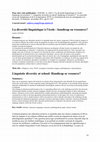
La nouvelle revuede l'adaptation et de la scolarisation, 2011
Comment proposer une éducation inclusive et équitable dans des classes composées d’élèves dont le... more Comment proposer une éducation inclusive et équitable dans des classes composées d’élèves dont les langues et les cultures reflètent une réalité sociale de migration de masse et/ou de plurilinguisme quotidien? Cette question préoccupe actuellement les acteurs éducatifs dans de nombreux pays de tradition multilingue et accueillant un
nombre croissant de migrants. La formation des professionnels de l’éducation demeure un domaine-clé dans la prise en compte de cette diversité linguistique et culturelle. L’importance du regard positif du professionnel sur l’élève qui parle une langue autre que le français à la maison et la nécessité de mieux comprendre des phénomènes complexes de plurilinguisme, de déracinement et de construction identitaire, sont au coeur des gestes et des postures professionnels qu’il convient de développer. Dans cet article, des voix d’enseignants expérimentés ainsi que des voix de futurs professionnels de l’éducation sont traitées afin d’identifier et d’analyser les défis que supposent la mise en place de formations cherchant à sensibiliser et à équiper les enseignants, éducateurs, psychologues scolaires, assistantes maternelles et tout autre acteur dans le domaine éducatif à répondre aux besoins spécifiques de cette population scolaire dans le contexte français.
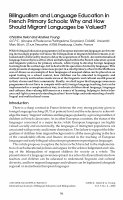
International Journal of Bilingual Education and …, Jan 1, 2002
While bilingual education programmes in European mainstream languages are becoming increasingly p... more While bilingual education programmes in European mainstream languages are becoming increasingly popular in France, the bilingualism of migrant children remains overlooked and is believed by many to delay the acquisition of French. An institutionalised language hierarchy lies all too often unchallenged within the French education system and linguistic policies for primary schools, while trying to develop foreign language learning from the earliest age, fail to deal with the question of minority languages. This study presents a language awareness project in a small primary school in the Mulhouse area of Alsace as an example of how languages of unequal status can be placed on an equal footing in a school context, how children can be educated to linguistic and cultural variety and teachers made aware of the linguistic and cultural wealth present in their classes and their community. Finally, we shall argue that language awareness programmes do not have to compete with early foreign language teaching, but can be implemented in a complementary way, to educate children about language, languages and cultures, thus valuing differences as a source of learning, helping to foster tolerance and fight racism and extending teachers' knowledge and understanding of multilingual and multicultural issues.
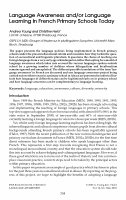
Language Awareness, Jan 1, 2003
The paper presents the language policies being implemented in French primary schools under the pr... more The paper presents the language policies being implemented in French primary schools under the present educational reform and considers how they tackle the question of sociocultural and linguistic pluralism. It questions the choice of teaching one foreign language from a very early age at kindergarten rather than opting for a model of language awareness which takes into account the various languages spoken outside school by a growing number of children whose bilingualism and biculturalism remains ignored and unexploited. The different possible translations of the term 'language awareness' in French are discussed and one language awareness project being carried out over three years in a primary school in Alsace are presented in order to illustrate how languages of different status can be legitimised early on in primary school and how language awareness can be complementary to language learning.
Imagining multilingual education in France: A language and cultural awareness project at primary level
… multilingual schools: Languages in education and …, Jan 1, 2006
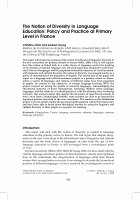
Language, Culture and Curriculum, Jan 1, 2005
This paper will present an analysis of the notion of cultural and linguistic diversity in the new... more This paper will present an analysis of the notion of cultural and linguistic diversity in the new curriculum for primary schools in France (MEN, 2003). First, it will explain how this notion is linked both to a wider choice of languages and to the teaching of one foreign or regional language only. We shall argue that, despite the wide theoretical choice of languages and the purported ministerial objective of 'familiarisation' with linguistic and cultural diversity, the notion of diversity is envisaged mainly as a policy to counterbalance the hegemony of English. The second part of the paper will report on a language and cultural awareness project in a primary school in Alsace, where a variety of languages and cultures of different status have been presented to pupils. In contrast to the objectives of foreign language teaching (FLT), the project focused on raising the profile of minority languages, acknowledging the educational potential of home bilingualism, educating children about language, languages, and the relativity of cultural practices, with the ultimate aim of fostering tolerance. Our analysis shows that, despite the reluctance of most French schools to move away from a monolingual habitus, some teachers are able to go beyond the top-down policies inscribed in the new curriculum. The teachers in the Didenheim project were not afraid to tackle the growing multilingualism within their classrooms and have been able to break down ideological barriers by using the linguistic and cultural diversity of their pupils as a resource for learning.
Motivational state and process within the sociolinguistic context: an Anglo-French comparative study of school pupils learning foreign languages
ABSTRACT Thesis (Ph. D.)--University of Aston in Birmingham, 1994.
ENSEMBLE
The ECML runs research and development projects within the framework of medium-term programmes of... more The ECML runs research and development projects within the framework of medium-term programmes of activities. These projects are led by international teams of experts and concentrate mainly on training multipliers, promoting professional teacher development and setting up expert networks. The ECML's publications, which are the results of these projects, illustrate the dedication and active involvement of all those who participated in them, particularly the project co-ordination teams.

Education à la diversité linguistique et culturelle: le rôle des parents dans un projet d'éveil aux langues en cycle 2
le Plurilinguisme en construction dans le système …, Jan 1, 2003
ABSTRACT Cette recherche fait partie d'un travail plus large portant sur la formation des... more ABSTRACT Cette recherche fait partie d'un travail plus large portant sur la formation des enseignants du primaire à la diversité linguistique et culturelle et sur l'écart entre les représentations du bilinguisme selon les langues et les élèves concernés. Elle part d'un constat : les enseignants stagiaires que nous formons en IUFM voient souvent le milieu familial comme responsable de certaines carences éducatives et la situation linguistique des enfants de migrants en particulier est perçue comme source de difficultés plutôt que comme un atout. Notre problématique de départ est la suivante : comment réduire l'écart entre les familles et l'école pour que l'enfant ne se sente pas écartelé entre deux mondes antagonistes, entre deux langues, deux cultures, ou comment réduire la distance entre la culture scolaire et les références familiales, pour que celle-ci ne soit pas facteur d'échec?

Diversity as an asset: Multiple language integration
How we're going about it. Teachers' voices on …, Jan 1, 2008
ABSTRACT One of the defining features of our era is the increasing mobility of people on a global... more ABSTRACT One of the defining features of our era is the increasing mobility of people on a global scale for professional, personal or economic reasons. Classes containing children of different cultural origins are no longer exceptional but have become the norm for many teaching professionals in schools throughout the world. How are we responding to this relatively recent phenomenon? How can we acknowledge and capitalise on the infinitely diverse sets of cultural and linguistic knowledge and skills which our pupils bring with them to school? How do we welcome these children and their families of diverse cultural heritages into our schools and our communities? How can we help them to feel comfortable, recognising and accepting their individual differences, whilst at the same time inviting them to become a constituent part of the class and the school? By moving our focus from the individual child to the educational community, a different perspective comes to light and a whole new series of questions arises. How should we be educating all the children in our classes, whatever their cultural and linguistic backgrounds, to respect difference? How can teaching professionals, whether working in large urban schools with a high proportion of children from migrant backgrounds or in small rural schools with less culturally diverse populations, foster curiosity, tolerance and empathy amongst all learners, including those for whom the wider world can seem very distant from their particular local context? In short, what kind of whole school approach (Camilleri, 2007) would allow us to encourage pupils to meet the social challenges facing global citizens of the twenty-first century? In his recent article Language Education, Identities and Citizenship: Developing Cosmopolitan Perspectives, Starkey defines such processes as education for “cosmopolitan citizenship” (Starkey, 2007: p.59-60) and identifies a need to provide “a space for learners to reflect on and develop new complex identities and articulate these with their understandings of citizenship” in our “multilingual world of increasing hybridity”. The issue of space, eking out a place in the already tightly packed school timetable to address issues linked to cosmopolitan citizenship, is also evoked by Garcia et al. who discuss “Weaving spaces and (de)constructing ways for multilingual schools” (Garcia et al. 2006). Garcia too has recognised the growing language and cultural hybridity of the 21st century and the need to invent educational models able to accommodate this hybridity (Garcia, 2004). In order to answer these two fundamental questions concerning how and when to teach about multiple languages and cultures within the school curriculum, a certain degree of creativity is required on the part of teachers. An account of how one school has chosen to meet these challenges follows below. It is hoped that others may find inspiration from this example and may in turn adapt the approach, which considers diversity as an asset and pupils and their families as a resource for learning about difference, to their own local contexts.







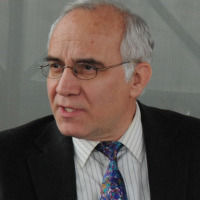



Uploads
Publications by Andrea Young
This article presents data from a longitudinal study undertaken in a pre-primary classroom of 3–4-year-old emergent bi/plurilingual children during their first year of formal schooling in France. It focuses on how the teacher’s intercultural competence facilitated the emergent bilingual children’s transition from home to school and fostered positive relationships with these parents and included them in the classroom. The data also suggest that the establishment of trusting relationships and safe spaces for these children and their families favoured the emergence of co- educational practices, namely in the area of literacy and fostered their well-being, learning and inclusion.
RESUMÉ
Cet article présente les données issues d’une étude longitudinale dans une classe de petite section maternelle d’enfants bilingues émergents âgés de 3 à 4 ans en France. Il s’intéresse à la façon dont les compétences interculturelles ont facilitéla transition des élèves bilingues émergents de la maison à l’école et ont favorisé les relations positives avec les parents en les incluant dans la salle de classe. Les données suggèrent que l’etablissement des relations de confiance et d’espaces sécurisants contribue a l’émergence de pratiques co-éducatives, notamment dans le domaine de la littératie favorisant ainsi leur inclusion, leur apprentissage et leur bien-etre.
Abstract According to many researchers and education professionals in Europe, our school populations are now characterized by multilingualism and multiculturalism for which educators are only slightly or not at all prepared. Ten years ago, a bi-national French-Scottish team endeavoured to respond to this question through the European project TESSLA (Teacher Education for the Support of Second Language Acquisition). The remit of this project was to design, experiment and evaluate a training module for trainee primary school teachers in order to raise their awareness of issues related to bilingualism and to the needs of their emergent bilingual pupils. Since 2005, the TESSLA course has been implemented among different contexts and audiences in various ways. This article aims to describe and analyze the different ways the course was implemented and through an analysis of data collected in 2013-2014 to develop a critical and constructive assessment of the results of the course implementation over the past 10 years.
Summary: This article focuses on the inclusive translanguaging practices observed over the course of a school year (2014-15) in one pre-primary classroom of children aged between three and four years in an urban, low socioeconomic status context in north eastern France where many children and families speak a language other than the language of schooling at home. The data (primarily video recordings and recorded interviews) reveal one teacher's practiced language policies underpinned by ideologies which embrace a holistic image of the child as she moves between worlds constructing meaning through complementary linguistic and cultural lenses. The creation of 'safe spaces' and the flexible use of languages by the teacher allow her to build bridges between languages, cultures and between school and home, and in so doing include all the children in the class.
Keywords: Plurilingual pedagogy-French-language of schooling-heritage/first language-Turkish-preschool
Résumé : L'étude porte sur des élèves bilingues émergents en Petite Section de maternelle en France. Dans l'enseignement, existent, en règle générale, des types de pédagogie monolingue qui ne tiennent compte ni des besoins ni des capacités des enfants bilingues. Dans cette étude qualitative, nous observons une enseignante de Petite Section qui a adapté sa pédagogie aux élèves bilingues émergents, turcophones dans la plupart des cas. Dans notre analyse, nous relevons l'utilisation de la langue d'origine en classe, la qualité de l'apport linguistique et les activités mises en place pour favoriser la littératie. Nos analyses permettent de constater que grâce à ses médiations les enfants participent beaucoup en classe, quel que soit leur niveau de français.
Abstract:This study focuses on emerging bilingual students in preschool in France. Generally, the educational system offers monolingual types of pedagogy that do not take in account the needs and capacities of bilingual children. In this qualitative study, we observe a preschool teacher who has adapted her pedagogy to the emerging bilingual children, mainly Turkish speaking. In the analysis, we will focus on the use of the first language in the classroom, the quality of linguistic input and the activities for promoting literacy. This allows us to illustrate that these children participate well in class, regardless of their level of French.
In this paper, we will present and analyse data from interviews with head teachers (n = 46) from a variety of schools in the Strasbourg area, north-east France. Critical, interpretive analysis of the reported discourse reveals evidence of linguistic hierarchies, separate spaces for different languages, a profusion of bilingual myths and a persistent monolingual habitus at school. Our findings underline the importance of uncovering and analysing teachers’ language ideologies in a bid to better understand the influences and obstacles preventing them from practising informed language policies with respect to plurilingual language development.
nombre croissant de migrants. La formation des professionnels de l’éducation demeure un domaine-clé dans la prise en compte de cette diversité linguistique et culturelle. L’importance du regard positif du professionnel sur l’élève qui parle une langue autre que le français à la maison et la nécessité de mieux comprendre des phénomènes complexes de plurilinguisme, de déracinement et de construction identitaire, sont au coeur des gestes et des postures professionnels qu’il convient de développer. Dans cet article, des voix d’enseignants expérimentés ainsi que des voix de futurs professionnels de l’éducation sont traitées afin d’identifier et d’analyser les défis que supposent la mise en place de formations cherchant à sensibiliser et à équiper les enseignants, éducateurs, psychologues scolaires, assistantes maternelles et tout autre acteur dans le domaine éducatif à répondre aux besoins spécifiques de cette population scolaire dans le contexte français.
This article presents data from a longitudinal study undertaken in a pre-primary classroom of 3–4-year-old emergent bi/plurilingual children during their first year of formal schooling in France. It focuses on how the teacher’s intercultural competence facilitated the emergent bilingual children’s transition from home to school and fostered positive relationships with these parents and included them in the classroom. The data also suggest that the establishment of trusting relationships and safe spaces for these children and their families favoured the emergence of co- educational practices, namely in the area of literacy and fostered their well-being, learning and inclusion.
RESUMÉ
Cet article présente les données issues d’une étude longitudinale dans une classe de petite section maternelle d’enfants bilingues émergents âgés de 3 à 4 ans en France. Il s’intéresse à la façon dont les compétences interculturelles ont facilitéla transition des élèves bilingues émergents de la maison à l’école et ont favorisé les relations positives avec les parents en les incluant dans la salle de classe. Les données suggèrent que l’etablissement des relations de confiance et d’espaces sécurisants contribue a l’émergence de pratiques co-éducatives, notamment dans le domaine de la littératie favorisant ainsi leur inclusion, leur apprentissage et leur bien-etre.
Abstract According to many researchers and education professionals in Europe, our school populations are now characterized by multilingualism and multiculturalism for which educators are only slightly or not at all prepared. Ten years ago, a bi-national French-Scottish team endeavoured to respond to this question through the European project TESSLA (Teacher Education for the Support of Second Language Acquisition). The remit of this project was to design, experiment and evaluate a training module for trainee primary school teachers in order to raise their awareness of issues related to bilingualism and to the needs of their emergent bilingual pupils. Since 2005, the TESSLA course has been implemented among different contexts and audiences in various ways. This article aims to describe and analyze the different ways the course was implemented and through an analysis of data collected in 2013-2014 to develop a critical and constructive assessment of the results of the course implementation over the past 10 years.
Summary: This article focuses on the inclusive translanguaging practices observed over the course of a school year (2014-15) in one pre-primary classroom of children aged between three and four years in an urban, low socioeconomic status context in north eastern France where many children and families speak a language other than the language of schooling at home. The data (primarily video recordings and recorded interviews) reveal one teacher's practiced language policies underpinned by ideologies which embrace a holistic image of the child as she moves between worlds constructing meaning through complementary linguistic and cultural lenses. The creation of 'safe spaces' and the flexible use of languages by the teacher allow her to build bridges between languages, cultures and between school and home, and in so doing include all the children in the class.
Keywords: Plurilingual pedagogy-French-language of schooling-heritage/first language-Turkish-preschool
Résumé : L'étude porte sur des élèves bilingues émergents en Petite Section de maternelle en France. Dans l'enseignement, existent, en règle générale, des types de pédagogie monolingue qui ne tiennent compte ni des besoins ni des capacités des enfants bilingues. Dans cette étude qualitative, nous observons une enseignante de Petite Section qui a adapté sa pédagogie aux élèves bilingues émergents, turcophones dans la plupart des cas. Dans notre analyse, nous relevons l'utilisation de la langue d'origine en classe, la qualité de l'apport linguistique et les activités mises en place pour favoriser la littératie. Nos analyses permettent de constater que grâce à ses médiations les enfants participent beaucoup en classe, quel que soit leur niveau de français.
Abstract:This study focuses on emerging bilingual students in preschool in France. Generally, the educational system offers monolingual types of pedagogy that do not take in account the needs and capacities of bilingual children. In this qualitative study, we observe a preschool teacher who has adapted her pedagogy to the emerging bilingual children, mainly Turkish speaking. In the analysis, we will focus on the use of the first language in the classroom, the quality of linguistic input and the activities for promoting literacy. This allows us to illustrate that these children participate well in class, regardless of their level of French.
In this paper, we will present and analyse data from interviews with head teachers (n = 46) from a variety of schools in the Strasbourg area, north-east France. Critical, interpretive analysis of the reported discourse reveals evidence of linguistic hierarchies, separate spaces for different languages, a profusion of bilingual myths and a persistent monolingual habitus at school. Our findings underline the importance of uncovering and analysing teachers’ language ideologies in a bid to better understand the influences and obstacles preventing them from practising informed language policies with respect to plurilingual language development.
nombre croissant de migrants. La formation des professionnels de l’éducation demeure un domaine-clé dans la prise en compte de cette diversité linguistique et culturelle. L’importance du regard positif du professionnel sur l’élève qui parle une langue autre que le français à la maison et la nécessité de mieux comprendre des phénomènes complexes de plurilinguisme, de déracinement et de construction identitaire, sont au coeur des gestes et des postures professionnels qu’il convient de développer. Dans cet article, des voix d’enseignants expérimentés ainsi que des voix de futurs professionnels de l’éducation sont traitées afin d’identifier et d’analyser les défis que supposent la mise en place de formations cherchant à sensibiliser et à équiper les enseignants, éducateurs, psychologues scolaires, assistantes maternelles et tout autre acteur dans le domaine éducatif à répondre aux besoins spécifiques de cette population scolaire dans le contexte français.
Drawing on research studies using complementary research approaches and from a variety of contexts across the globe, in this chapter questions are raised concerning school language policies, both overt and covert (Spolsky 2004; Bonacina-Pugh, 2012), learner well-being and self esteem (Moro, 2012) and teacher language awareness. In addition, this contribution will attempt to tease out some of the complex issues surrounding linguistic diversity in primary and pre-primary settings and to examine their conceptualisation in terms of translanguaging (Garcia & Wei, 2014), safe spaces (Conteh & Brock, 2011), the plurilingual repertoire (Council of Europe) and the common underlying language proficiency (Cummins, 2001).
Although the focus of the chapter will be on the learner and learning, as the chapter attempts to explore avenues for further research and continuing professional development, the teacher will also be considered as a learner and as such as a key actor in the linking of research with practice.
References:
Bonacina-Pugh, F. 2012. Researching ‘practiced language policies’: insights from conversation analysis. Language Policy, 11.3, 213-234.
Conteh, J. & Brock, A. (2011): ‘Safe spaces’? Sites of bilingualism for young learners in home, school and community, International Journal of Bilingual Education and Bilingualism, 14:3, 347-360
Cummins, J. 2001. An Introductory Reader to the Writings of Jim Cummins, Clevedon, UK: Multilingual Matters.
García, O. & Wei, L. 2014. Translanguaging: Language, bilingualism and education, Basingstoke, UK, Palgrave Macmillan.
Moro, M. R., Peiron, D. & Peiron, J. 2012. Enfants de l'immigration, une chance pour l'école, Bayard.
Spolsky, B. 2004. Language policy, Cambridge, Cambridge University Press.